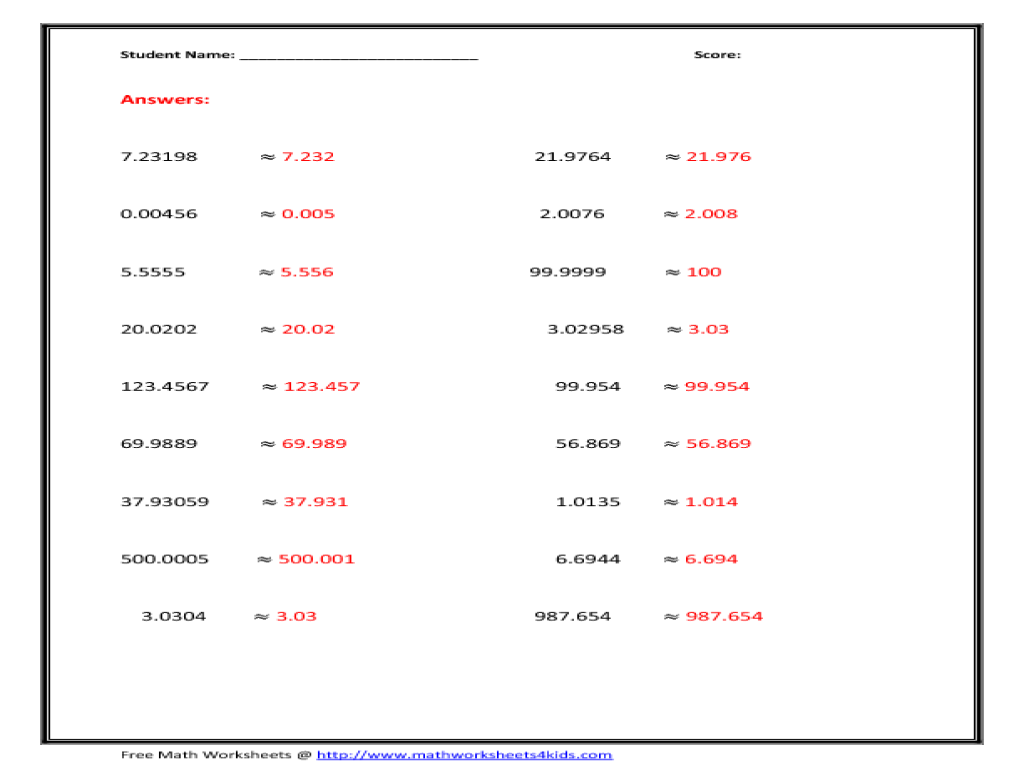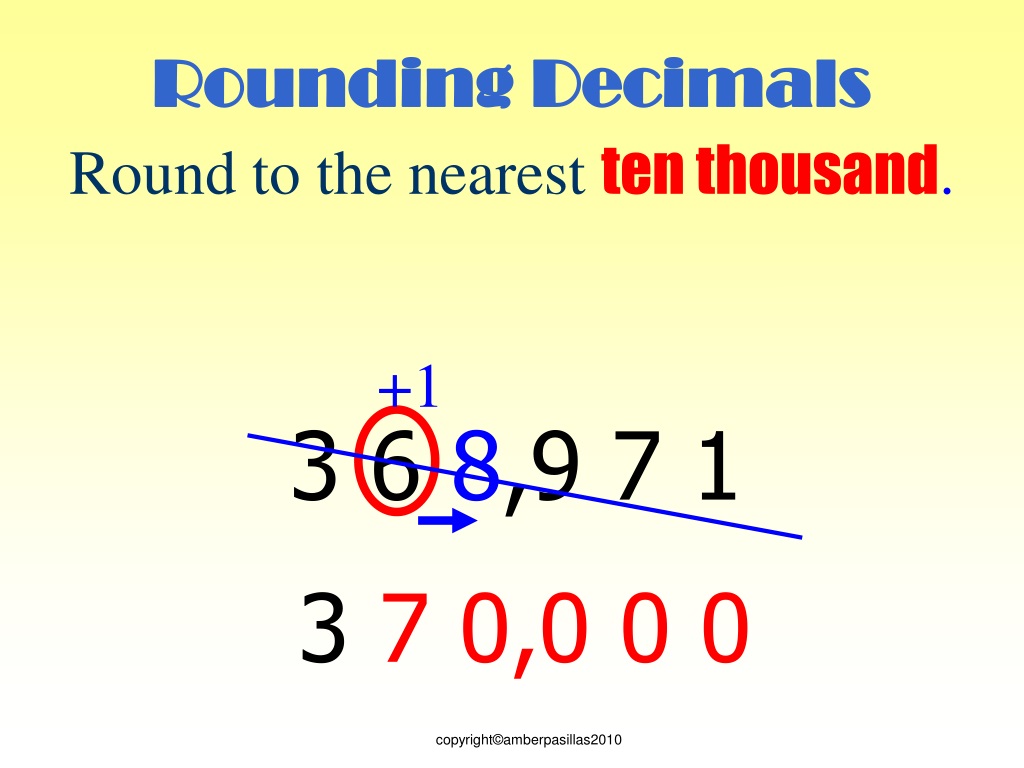Rounding to the nearest thousandth is a fundamental mathematical concept that simplifies numbers while maintaining their approximate value. Whether you're a student learning basic arithmetic or a professional working with complex calculations, understanding this process is essential. This article will guide you through everything you need to know about rounding numbers to the nearest thousandth, making it easier for you to handle numerical data accurately.
Rounding numbers is not just a mathematical skill but also a practical tool used in everyday life. From budgeting to scientific research, rounding numbers helps in making estimations and simplifying complex data. The process of rounding to the nearest thousandth is particularly important when dealing with decimals, as it provides a precise yet manageable approximation.
Whether you're solving math problems, analyzing data, or working with measurements, mastering the art of rounding to the nearest thousandth is invaluable. This guide will break down the concept step-by-step, ensuring you have a clear understanding of how to apply it effectively. Let's dive into the details and explore the significance of this mathematical technique.
Understanding the Basics of Rounding Numbers
Rounding numbers is a process of approximating a number to make it simpler while keeping its value close to the original. This technique is widely used in various fields, including finance, engineering, and science. When rounding to the nearest thousandth, the focus is on the third digit to the right of the decimal point.
Here are the key points to consider:
- Rounding involves identifying the place value you want to round to.
- Look at the digit immediately to the right of the place value you're rounding to.
- If this digit is 5 or greater, round up. If it's less than 5, round down.
This process ensures that the rounded number remains close to the original value, making it easier to work with in calculations and estimations.
What Does "Rounded to the Nearest Thousandth" Mean?
Rounding to the nearest thousandth means adjusting a number to its closest value with three decimal places. This process is particularly useful when dealing with precise measurements or calculations that require accuracy up to three decimal places.
For example, consider the number 3.14159. When rounded to the nearest thousandth, it becomes 3.142. This adjustment simplifies the number while preserving its approximate value.
This technique is commonly used in fields such as engineering, physics, and statistics, where precise calculations are crucial. By understanding how to round to the nearest thousandth, you can ensure that your data is both accurate and manageable.
Steps to Round Numbers to the Nearest Thousandth
Identify the Thousandth Place
The first step in rounding to the nearest thousandth is identifying the thousandth place in the number. This is the third digit to the right of the decimal point. For instance, in the number 7.8943, the thousandth place is 4.
Examine the Digit to the Right
Once you've identified the thousandth place, look at the digit immediately to its right. This digit will determine whether you round up or down. In our example, the digit to the right of 4 is 3.
Apply the Rounding Rule
If the digit to the right is 5 or greater, increase the thousandth place by 1. If it's less than 5, leave the thousandth place unchanged. In our example, since the digit is 3, we round down, resulting in 7.894.
Following these steps ensures that you round numbers accurately and consistently.
Practical Examples of Rounding to the Nearest Thousandth
Let's explore some practical examples to solidify your understanding:
- Example 1: Round 5.6789 to the nearest thousandth. The thousandth place is 8, and the digit to the right is 9. Since 9 is greater than 5, round up to 5.679.
- Example 2: Round 2.3456 to the nearest thousandth. The thousandth place is 5, and the digit to the right is 6. Since 6 is greater than 5, round up to 2.346.
- Example 3: Round 8.1234 to the nearest thousandth. The thousandth place is 3, and the digit to the right is 4. Since 4 is less than 5, round down to 8.123.
These examples demonstrate how the rounding process works in practice, ensuring you can apply it confidently in various scenarios.
Applications of Rounding to the Nearest Thousandth
Scientific Research
In scientific research, precision is paramount. Rounding to the nearest thousandth allows researchers to present data in a manageable format without losing significant accuracy. This is especially important in fields like physics and chemistry, where measurements often involve decimals.
Engineering and Construction
Engineers and architects frequently use rounding to simplify calculations while maintaining the integrity of their designs. By rounding measurements to the nearest thousandth, they can ensure that their projects meet the required specifications.
Financial Analysis
In finance, rounding numbers to the nearest thousandth helps in creating accurate reports and budgets. This process ensures that financial data is presented clearly and consistently, aiding in decision-making processes.
These applications highlight the importance of rounding in various industries, emphasizing its practical value.
Common Mistakes to Avoid When Rounding
While rounding to the nearest thousandth is a straightforward process, there are common mistakes to avoid:
- Over-Rounding: Rounding too frequently can lead to significant inaccuracies in calculations. It's essential to round only when necessary.
- Incorrect Identification of Place Values: Misidentifying the thousandth place can result in incorrect rounding. Always double-check the position of the digits.
- Ignoring Rounding Rules: Failing to follow the rules for rounding up or down can lead to errors. Ensure you apply the rules consistently.
By being aware of these potential pitfalls, you can improve the accuracy of your rounding process.
Advanced Techniques for Rounding
Rounding in Spreadsheets
Spreadsheets like Microsoft Excel and Google Sheets offer built-in functions for rounding numbers. The ROUND function allows you to specify the number of decimal places to which you want to round. For example, =ROUND(3.14159, 3) will return 3.142.
Programming Languages
In programming, rounding functions are available in most languages. For instance, in Python, the round() function can be used to round numbers to the nearest thousandth. This makes it easier to handle numerical data in software applications.
Statistical Rounding
In statistics, rounding techniques such as "bankers' rounding" are used to minimize bias in calculations. This method rounds to the nearest even number when the digit to the right is exactly 5, ensuring more accurate results over large datasets.
These advanced techniques expand the utility of rounding beyond basic arithmetic, making it a versatile tool in various fields.
Why Rounding to the Nearest Thousandth Matters
Rounding to the nearest thousandth is more than just a mathematical exercise. It plays a crucial role in simplifying complex data while maintaining its accuracy. This process is vital in fields where precision and clarity are essential, such as healthcare, finance, and scientific research.
For example, in medical studies, rounding measurements to the nearest thousandth ensures that data is presented in a way that is both understandable and reliable. In finance, rounding helps in creating accurate reports that aid in decision-making. Understanding the importance of rounding can enhance your ability to work with numerical data effectively.
By mastering this skill, you contribute to the accuracy and reliability of the data you handle, making it an indispensable tool in your professional toolkit.
Conclusion and Next Steps
Rounding to the nearest thousandth is a valuable skill that simplifies numbers while preserving their approximate value. This article has covered the basics of rounding, practical examples, common mistakes to avoid, and advanced techniques for applying this concept in various fields. By following the steps outlined here, you can confidently round numbers to the nearest thousandth in any context.
We encourage you to practice rounding with different numbers and scenarios to reinforce your understanding. Don't hesitate to share this article with others who might benefit from it, and feel free to explore more articles on our site for additional insights into mathematics and related topics. Your feedback and questions are always welcome!
Table of Contents
- Understanding the Basics of Rounding Numbers
- What Does "Rounded to the Nearest Thousandth" Mean?
- Steps to Round Numbers to the Nearest Thousandth
- Practical Examples of Rounding to the Nearest Thousandth
- Applications of Rounding to the Nearest Thousandth
- Common Mistakes to Avoid When Rounding
- Advanced Techniques for Rounding
- Why Rounding to the Nearest Thousandth Matters
- Conclusion and Next Steps

